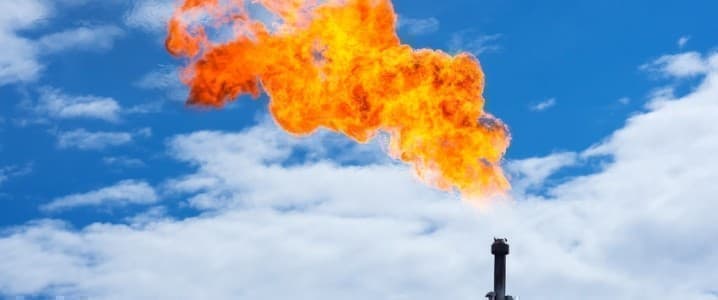According to the World Bank, energy companies around the world flared 250 billion cubic meters of natural gas last year. That is the highest gas flaring rate since 2009, representing billions in lost profits from wasted gas. But there may be a clever solution to this problem: turn the gas into LNG and sell it abroad. LNG is a hot commodity despite a glut that has driven prices to historic lows, making some large-scale LNG projects economically unviable. Yet not all LNG facilities are large and cost billions to build. Nowadays, there are also mini-LNG plants that produce gallons instead of tons of the superchilled liquid gas. And, according to some, they can solve the flaring problem, at least in the Permian.
This is what the Houston Chronicle’s Jim Magill wrote in a recent article on flaring and LNG production. Small LNG plants churn out up to 100,000 gallons of LNG daily, which can then be transported to power plants and ports to fuel ships. It is already being done in some parts of the United States, but not the shale plays where the gad flaring actually occurs.
Globally, gas flaring costs oil producers some $17 billion in lost sales, according to UK-based flaring solutions providers Capterio. It also costs a lot in emissions, which is the reason flaring has been drawing increasing attention from regulators. Even the Texas Railroad Commission, which has been generous with flaring permits, recently approved changes to the regulatory framework around flaring that aims to reduce the amount of gas burned at oil fields.
In truth, flaring in the Permian fell sharply as oil production fell. New gas pipelines in the Permian have also helped the situation. But they have not solved the problem once and for all.
“Since the downturn, the rate of flaring has gone down with more than 99.5 percent of the gas produced in the month of May sold and beneficially used to generate electricity, cook dinner, or make hundreds of consumer products,” said the chairman of the Texas Railroad Commission in comments on the new rules. “Now is the opportune time to implement meaningful recommendations to reduce flaring before oil and gas production climbs back to previous highs.” Related: Where Will The World’s Next Giant Gold Discovery Be Made?
Production is already coming back on stream, and the flares will follow. Setting a mini-LNG train on-site could be the perfect solution, at least for those who have money to spare. Small-scale LNG trains may not cost billions to build, but they are not cheap either.
One southern Texas small-scale LNG plant, operated by Stabilis Energy, cost between $40 and $45 million to build, according to its CEO Jim Reddinger, who spoke to Chron’s Magill. The plant has a capacity of 100,000 gallons of LNG daily. It distributes its liquefied gas to various businesses across North America. But can the market support a dozen more LNG suppliers of this size?
This is the million-dollar question. The global LNG market is oversupplied, and this is already hurting U.S. LNG producers. Things are beginning to improve, with fewer U.S. cargos being canceled for delivery in September and October, but the situation on the LNG market is pretty similar to that on the oil market. There is way more supply than there is demand. In this context, which also features depressed investment appetite among energy companies, the chances are that few would be willing to consider solving their flaring problem by building small-scale LNG plants.
According to some in the industry, mini-LNG trains could help drillers save money. Chron’s Magill quotes the head of a former owner of a small-scale LNG plant, Kelley GTM Manufacturing, as saying LNG could be regasified and used to power drilling equipment in the field, replacing costlier diesel. The question here is, why liquefy and regasify when you have the gas as is at the field. Yet liquefied gas can also be used as fuel for machinery, and it could be a cheaper and cleaner alternative to diesel.
Be that as it may, the challenges for mini-LNG plants seem to be identical to those that large-scale plants have: securing long-term customers. In a low-price environment, many buyers prefer to tap the spot market than to commit to long-term contracts that are the bread and butter of LNG producers. For all the benefits that small-scale LNG plants can deliver in the gas flaring department, finding enough consumers for the fuel remains the major challenge. This is because demand for LNG as fuel for oil production equipment depends on oil demand.
Mini-LNG plants at the oil field only make sense if there are enough rigs and hydraulic pumps to be fuelled with gas. An alternative use is as fuel for ships—demand for LNG-powered smaller vessels is on the rise. But given the amounts of LNG that are used as fuel, small-scale producers would have to face the stiff competition of larger LNG companies.
ADVERTISEMENT
Replacing flaring with LNG production certainly sounds like a good idea. It could be a particularly good idea for bigger flarers than the United States, such as Iraq. But whether it is a good idea for the Permian right now remains to be seen.
By Irina Slav for Oilprice.com
More Top Reads From Oilprice.com:
- Is Argentina’s Shale Too Expensive To Drill?
- 3 Energy Stocks To Consider Even As Markets Remain Stagnant
- U.S. Pushes Iraq To Cut Energy Dependence On Iran



















The burn it in a clean way and turn it into electricity, cheap, easy to do and they rent the equipment.